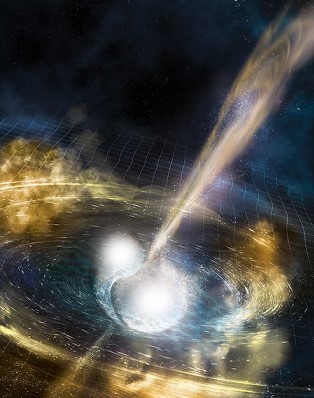
Artist's illustration of two merging neutron stars. The rippling space-time grid represents gravitational waves that travel out from the collision, while the narrow beams show the bursts of gamma rays that are shot out just seconds after the gravitational waves. Swirling clouds of material ejected from the merging stars are also depicted. The clouds glow with visible and other wavelengths of light. Credit: NSF/LIGO/Sonoma State University/A. Simonnet
WASHINGTON (AP): It was a faint signal, but it told of one of the most violent acts in the Universe, and it would soon reveal secrets of the cosmos, including how gold was created.
Astronomers around the world reacted to the signal quickly, focusing telescopes located on every continent and even in orbit to a distant spot in the sky.
What they witnessed in mid-August and revealed on Monday was the long-ago collision of two neutron stars, a phenomenon California Institute of Technology's David H. Reitze called "the most spectacular fireworks in the Universe."
"When these things collide, all hell breaks loose," he said.
Measurements of the light and other energy emanating from the crash have helped scientists explain how planet-killing gamma ray bursts are born, how fast the Universe is expanding, and where heavy elements like platinum and gold come from.
"This is getting everything you wish for," said Syracuse University physics professor Duncan Brown, one of more than 4,000 scientists involved in the blitz of science that the crash kicked off. "This is our fantasy observation."
It started in a galaxy called NGC 4993, seen from Earth in the Hydra constellation. Two neutron stars, collapsed cores of stars so dense that a teaspoon of their matter would weigh 1 billion tons, danced ever faster and closer together until they collided, said Carnegie Institution astronomer Maria Drout.
The crash, called a kilonova, generated a fierce burst of gamma rays and a gravitational wave, a faint ripple in the fabric of space and time, first theorized by Albert Einstein.
The signal arrived on Earth on Aug. 17 after traveling 130 million light-years. A light-year is 5.88 trillion miles.
NASA's Fermi telescope, which detects gamma rays, sent out the first alarm. Then, 1.7 seconds later, gravity wave detectors in Louisiana and Washington state that are a part of the LIGO Laboratory, whose founders won a Nobel Prize earlier this month, detected the crash. It issued a worldwide alert to focus telescopes on what became the most well-observed astronomical event in history.
Before August, the only other gravity waves detected by LIGO were generated by colliding black holes. But black holes let no light escape, so astronomers could see nothing.
This time there was plenty to see, measure and analyze: matter, light, and other radiation. The Hubble Space Telescope even got a snapshot of the afterglow.
"The completeness of this picture from the beginning to the end is unprecedented," said Columbia University physics professor Szabolcs Marka. "There are many, many extraordinary discoveries within the discovery."
The colliding stars spewed bright blue, super-hot debris that was dense and unstable. Some of it coalesced into heavy elements, like gold, platinum and uranium. Scientists had suspected neutron star collisions had enough power to create heavier elements, but weren't certain until they witnessed it.
"We see the gold being formed," said Syracuse's Brown.
Calculations from a telescope measuring ultraviolet light showed that the combined mass of the heavy elements from this explosion is 1,300 times the mass of Earth. And all that stuff, including lighter elements, was thrown out in all different directions and is now speeding across the universe.
Perhaps one day the material will clump together into planets the way ours was formed, Reitze said, maybe ones with rich veins of precious metals.
"We already knew that iron came from a stellar explosion, the calcium in your bones came from stars and now we know the gold in your wedding ring came from merging neutron stars," said University of California Santa Cruz's Ryan Foley.
The crash also helped explain the origins of one of the most dangerous forces of the cosmos, short gamma ray bursts, focused beams of radiation that could erase life on any planet that happened to get in the way. These bursts shoot out in two different directions perpendicular to where the two neutron stars first crash, Reitze said.
Luckily for us, the beams of gamma rays were not focused on Earth and were generated too far away to be a threat, he said.
Scientists knew that the Universe has been expanding since the Big Bang. By using LIGO to measure gravitational waves while watching this event unfold, researchers came up with a new estimate for how fast that is happening, the so- called Hubble Constant. Before this, scientists came up with two slightly different answers using different techniques. The rough figure that came out of this event is between the original two, Reitze said.
The first optical images showed a bright blue dot that was very hot, which was likely the start of the heavy element creation process amid the neutron star debris, Drout said.
After a day or two that blue faded, becoming much fainter and redder. And after three weeks it was completely gone, she said.
Scientists involved with the search for gravitational waves said this was the event they had prepared for over more than 20 years.
The findings are "of spectacular importance," said Penn State physicist Abhay Ashtekar, who wasn't part of the research. "This is
really brand new."
 Previous Article
Previous Article Next Article
Next Article













The Indian Air Force, in its flight trials evaluation report submitted before the Defence Ministry l..
view articleAn insight into the Medium Multi-Role Combat Aircraft competition...
view articleSky enthusiasts can now spot the International Space Station (ISS) commanded by Indian-American astr..
view article